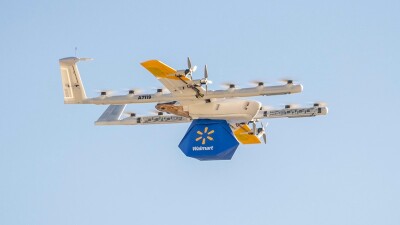Colin Guinn’s history with drones goes beyond his experiences and positions with DJI and 3DR. His passion for UAVs and aerial cinematography led to the creation of his aerial cinematography company Avean Media, where Colin grew into one of the world’s top UAV flight and design experts. That passion fueled many of his roles throughout the industry, and it’s taking center stage with his work at Guinn Partners, where his team is focused on helping launch products, evaluate new markets, and execute state-of-the-art marketing strategies.

The Future of Drone Hardware
The
State of the Drone Industry and
Going Beyond Visual Line of Sight reports are a couple examples of resources Guinn Partners has created, but Colin provides a much better sense of his expertise and experience via the videos he’s been releasing. These videos have been focused on everything from
detailing why BVLOS is so important to
answering questions from the Guinn Partners mailbag. His most recent video pushes back again the pervasive narrative in the drone industry about drone hardware already being commoditized, and
why drone hardware is NOT dead.
We’ve explored that topic in detail with Colin
in Part 1 of our interview with him, where he explained what needs to change with this topic and how it will impact the future of the technology. In Part 2, we asked him about what it means for him to be the voice of reason when it comes to launching a product and whether or not the drone industry can only take off once BVLOS operations are more easily enabled.
Jeremiah Karpowicz: How does your focus on the practicalities of drone technology play into the services and resources offerings that are available at Guinn Partners? 
Colin Guinn
: What we do is help take a potential innovation, or a potential new technology, and figure out how to actually fit this new technology into the real-world market of people that have their own defined workflows in place. You can't just be a little bit better and expect these massive companies to shift the way they do business and change their workflows to adopt your new technology because you're saving 10% of time and money. The cost of change is so much higher than that.
What we'll see happen is that a company will make a drone that possesses a certain capability someone has engineered or envisioned. But then they'll ask why no one is buying their product. Well, how many customers did they talk to before they made the thing? Was it really a problem that needed to be solved?
So much of it comes down to engaging with the market and trying to determine the problem they're having today, and what it's costing them. And then figuring out if that problem can be solved through the uses of technology like drones or automation.
Are many of these companies really not asking questions related to how their product fits into the market? What happens a lot of times is that teams will create a product or prototype that works really well, then they get funded, and then they shift all their focus away from the product to build a team and create a go-to-market strategy. These innovators and engineers don't even know the right questions to ask when building these teams. So much of their focus is taken away from the product, and the product gets delayed, or it's not as robust as it needs to be by the time it launches. And those are mistakes we learned firsthand.
At Guinn Partners, we try to bring all of the successes and failures that we've all had in this industry to our clients to help them make validated decisions around what they should be doing, when they should be doing it, what they should be developing, find their customers, etc. We find ourselves constantly fighting this battle to be the voice of reason, so that we can help them grow into a certain size, and then get their own teams in place.
Being the voice of reason in those sorts of meetings isn’t a familiar role for you, is it? It is not! That’s part of the reason I can have these conversations though. I meet with a lot of people who are developing something new, and I have to convince them that their v1 is not going to work the way they think it's going to work, and it's not going to be done by the time they think it's going to be done. We've seen it happen enough over the last decade plus.
A lot of that is the result of new companies getting into drones that don’t have a history with the technology. The thing is, if someone just got into drones 2-3 years ago, and they decided they wanted to raise money and build a cool drone that's autonomous or carries people around, the vast majority of those individuals think drones are already perfect.
It goes back to the notion of hardware being a solved problem, and the sense that drones are invincible. Of course, much of that comes from the reliability of the drones sold by DJI, and we have to get them to realize that none of that really translates to someone who's making his or her first drone ever.
That sort of insight was front and center in your State of the Industry report, which showcased many of the topics and concepts that are and will be defining this industry. What were some of the high-level insights that you took away from the experience of assembling that report?One of the things that stuck out to me is how much has changed for the people creating and buying and using this technology.
Back in the day at DJI, we had a lot of drones that had a lot of problems, and we learned a lot and squashed a lot of bugs by having a whole bunch of drones fly away and flip out of the sky. We got lucky that nothing really bad happened, but there were no other options on the market at the time, and we were selling to a bleeding edge audience that was really forgiving to that fact. But that's not the market anymore. Especially as the commercial drone market starts to become more mature, if you're going to develop an autonomous drone in a box solution to scan mines or to scan a construction site, there is no leeway for error. It has to work perfectly. And it has to work every single time. You can't risk having a 20-lb drone falling out of the sky and landing on a worker's head.
What also stuck out to me was a real change in terms of how people who aren't deeply involved in this industry understand where drones are going and how they're going to impact our society. That was really exciting to document.
What do you mean? The example I use is that if you asked the average person what they thought about drones in 2013, most of them would talk about Predator drones and how they’re used to bomb people in other countries. Almost all of it would be in a military context. In the drone industry itself, our perception was that they were a new way to carry a camera and collect data, but the vast majority of the world had no idea about any of that.
Fast-forward to now, and when you say “drone”, people think of Phantoms and Mavics and flying cameras. That's the perception of the general public and investor community with drone technology. It’s a great thing, but we can already see another similar shift forward in terms of how the drone industry wants to use the technology. Because we're looking at full autonomy, computer vision, smart cities, smart farms, real-time insights around mining, better inspection of critical infrastructure…all of that hasn't materialized yet, but they’re all things that will be solved in the next 1-3 years. So in 3-5 years from now, when someone hears the word "drone" they'll just think of them as something that files around and does work all day. They’ll think of them as the things that deliver them their packages.
The general public is not thinking about drones like that now, but watching how these perceptions and understandings of the technology shift is really illuminating. It won’t be long before they figure out there's a lot more to drones than just flying a camera around for 30 minutes.
Speaking of changing perceptions, you recently released your Going Beyond Visual Line of Sight report, which is a free resource to help companies understand the regulations and standardization that need to be taken into consideration. It’s a concise and informative read, so rather than ask you to repeat any insights more clearly laid out there, I’ll ask you something that often comes up whenever we talk BVLOS: will the real value associated with drone technology only be realized once it’s easier from a regulatory standpoint for operators to fly BVLOS? I would say that autonomous BVLOS operations will enable a major tipping point for the commercial drone industry. That's a difference you can see when you compare the commercial drone industry to the consumer drone industry.
In the consumer drone industry, flying the drone is the meat. Someone flies their drones and takes some pictures or video, and that’s the end of it. It’s all they want to do. That's the consumer drone space. In the commercial drone space, it's not about flying the drone, but it's not about going and collecting raw data either. It's really about answers associated with whether or not a foundation was poured in the right spot. It’s about identifying a spot on a power line where preventative maintenance resolves an issue before it becomes a problem. Commercial users don’t care about the drone, they just want to know things like how many dump trucks they're going to need to move an aggregate from one job site to another. They want to know whether they can better their margins by 2% to offer a better price and stay competitive with their bid. It has nothing to do with the drone or even the raw data. It's just about the insights that someone can get.
If we all agree that the business use of drones has to do with the added information that someone gets, and the added context to the problem that they're able to make a more informed decision, then that’s where you’re going to see and create value. It's not about the drone, it's about what someone is trying to ascertain and get from the drone. That’s the tipping point when it comes to the value of the technology.
So the value of drone technology isn’t tied to BVLOS operations specifically, but more to autonomous operations that can be reliably carried out, regardless of the distance or task? The value all relates to economics and the cost model of operating drones.
If you think about it, a drone is just a Roomba. We know the value of having a Roomba as it relates to vacuuming a floor, so imagine if every time someone used a Roomba, they had to stand in the room and watch it run, ready to stop it or trouble-shoot if it got stuck. No one would use them, because then you'd just use a vacuum. As long as we have to pay operators to do the equivalent of vacuum the floor, then there's only going to be a certain part of the market where the value that's derived from that info and insight justifies that cost.
And that value is certainly there today. You have energy inspections, critical infrastructure inspections, construction sites and plenty other use cases of drones where the value that's created is so high that it makes sense to potentially pay someone hundreds of dollars per hour to make this happen. If that were all that ever happened, then the industry would continue to grow and still become an industry worth billions of dollars. However, the moment that collecting that data, processing that data, and delivering those insights, becomes fully autonomous, everything changes.
When we get there, the cost of operating a drone will go down to pennies per hour, and then the technology makes sense in a whole lot more industries. At that point, entirely new value propositions will be created. It's still going to take years, but that will be a major unlocking event.
It's always fun to think about the future, but if someone can make the technology make sense for their bottom line right now, how concerned should they be about when or how we reach this tipping point? There’s going to be a whole new world of opportunity in hardware. As soon as the drone can operate by itself, a whole new slew of opportunities will be opened up because so much of why the drone looks like it does today is because we can only use them in certain ways.
People can and are using the technology to create value today, but the more the drone can do autonomously, the less anyone is going to want to use them the way they are right now. Yes, you can get what you needs to be done on a construction site with a Phantom and DroneDeploy or Pix4D, but we’re going to reach a point where a construction site can be autonomously inspected enough to automatically compare the as-planned PDF with the as-built reality and spot issues before they turn into mistakes. That's going to require a whole different set of hardware.
Anyone who’s only focused on or interested in how the technology can be utilized right now is looking at drones in a limited scope.


















Comments